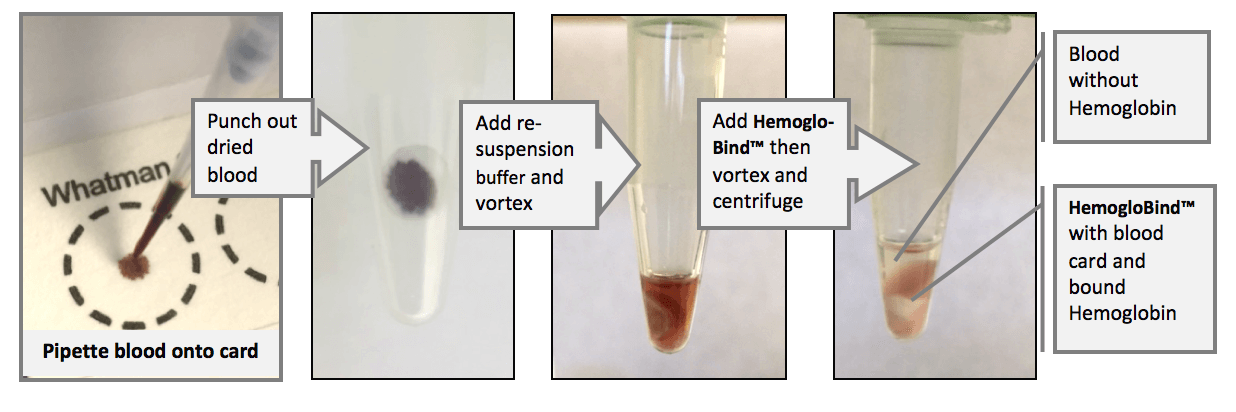
Using HemogloBind™ as a Hemoglobin Binding Reagent
Validation of a unique Hemoglobin binding reagent, HemogloBind™, for whole blood, dried blood spot and hemolyzed serum.
Background
Hemoglobin is a common interference with many different types of analytes and analytical platforms. Due to its high abundance, it can also be very problematic in proteomic investigations.
BSG has developed a hemoglobin binding reagent,
HemogloBind™, used for a number of applications in blood substitutes, enzyme recovery and analytical interfaces. It provides a simple method to greatly reduce the influence of Hemoglobin in a variety of applications.
It has been extensively cited in journal articles such as "
Deleterious Effect of Advanced CKD on Glyoxalase System Activity not Limited to Diabetes Aetiology."
Challenge
Due to its spectral properties, Hemoglobin can often pose analytical challenges when either the analyte of interest or the reporting measurement spectrally overlap. This can often be the case for bilirubin, enzyme assay and ELISA analyses. In addition to its spectral properties, Hemoglobin is the highest abundance protein in whole blood, so proteomic investigations derived from whole blood can be severely compromised by its influence.
Solution
HemogloBind™ comes from a class of solid-phase elastomeric poly-electrolytes that bind hemoglobin through an empirically derived chemistry combining elements of polymer composition, cross-linking architecture and charge properties. Without the use of antibodies or biologically derived ligands, HemogloBind™ provides a high degree of selectivity towards Hemoglobin and does not cross-react with most common serum components, making it an excellent tool in numerous applications.
In this particular study, cited above, the authors describe the simplicity and efficiency of their the HemogloBind™hemoglobin depletion technology for improving Western blot analysis from whole blood.
Outcome
A key feature in HemogloBind™ is to not only remove and capture hemoglobin, but also to do so with a high degree of selectivity that does not cross-react with other common serum components. The above article, along with the research articles demonstrated below, illustrate the efficiency of HemogloBind™, an excellent tool in numerous applications.
These include bilirubin analysis, whole blood analysis and dried blood spots.
For Bilirubin Analysis
"To remove free Hb that may cause optical interference in bilirubin analysis, we treated all the samples with Hb depletion from hemolyzed serum/plasma (HemogloBind, Biotech Support Group)."
Citation is: Parvathi S. Kumar, Haree K. Pallera, Pamela S. Hair, Magdielis Gregory Rivera, Tushar A. Shah, Alice L. Werner,Frank A. Lattanzio, Kenji M. Cunnion, and Neel K. Krishna. Peptide inhibitor of complement C1 modulates acute intravascular hemolysis of mismatched red blood cells in rats. TRANSFUSION Volume 00, May 2016. doi:10.1111/trf.13674.
"Due to large amounts of hemolysis in the latter time points and the associated optical interference in bilirubin analysis, all the samples were pre-treated with HemogloBind™ prior to analysis with the Bilirubin Assay Kit"
Citation is: Krishna, Neel K., and Kenji Cunnion. "Derivative Peptide Compounds and Methods of Use." U.S. Patent No. 20,160,376,322. 29 Dec. 2016.
For Whole Blood Analysis
"For protein isolation, whole blood aliquots were lysed with water and haemoglobin was removed using HemogloBind™ (Biotech Support Group) according to manufacturer’s instructions…".
Citation is: Chalásová, Katarína, et al. "Transketolase Activity but not Thiamine Membrane Transport Change in Response to Hyperglycaemia and Kidney Dysfunction." Experimental and Clinical Endocrinology & Diabetes (2017). https://www.thieme-connect.com/products/ejournals/abstract/10.1055/s-0043-115009
"Briefly, whole blood samples were treated with HemogloBind™ which interferes with the ChE activity assay due to spectral overlap."
Citations for Cholinesterase: McGarry, Kevin G., et al. "Evaluation of HemogloBind™ treatment for preparation of samples for cholinesterase analysis." (2013). Advances in Bioscience and Biotechnology, 2013, 4, 1020-1023; and Brittain, Matthew K., Kevin G. McGarry, Robert A. Moyer, Michael C. Babin, David A. Jett, Gennady E. Platoff, and David T. Yeung. "Efficacy of Recommended Prehospital Human Equivalent Doses of Atropine and Pralidoxime Against the Toxic Effects of Carbamate Poisoning in the Hartley Guinea Pig." International journal of toxicology (2016): 1091581816638086.
BSG Application Report – Performance Characteristics of HemogloBind™ on Whole Blood
For Dried Blood Spots
"Hemoglobin depletion improves PRM panel coverage in DBS and volumetric adsorptive microsampling (VAMS)".
Citation is: Michelle R. Robinson, Lei Guo; Raymond J. Gonzalez; Kara M. Pearson; Kevin P. Bateman; Daniel S. Spellman. Differentiating Modes of Drug Induced Liver Injury Using Parallel Reaction Monitoring LC-MS. ASMS Conference 2017 poster report.
"…Hb can be removed using a commercial product, HemogloBind™, which can isolate and remove up to 90% of blood Hb."
Citations is: Hakuna, Lovemore, et al. "A simple assay for glutathione in whole blood."Analyst (2015). (http://pubs.rsc.org/en/content/articlelanding/2015/an/c5an00345h)
See more:
BSG Application Report – Performance Characteristics of HemogloBind™ on Dried Blood Spots
Additional Key Advantages of HemogloBind™:
- HemogloBind™ has a high degree of specificity for hemoglobin binding up to 10 mg/ml.
- Because it is species agnostic, HemogloBind™ works on human, mouse, rat, sheep, goat, etc.
- The flow through fractions retain their enzymatic and biological activity.
- The flow through fractions are compatible with LC-MS, activity-based protein profiling and proteomic studies.
Click to view all Hemoglobin Depletion products.
BSG Featured Advantages
- Consumable Use: Not derived from biologicals, no regeneration, cost-effective, no specialized instruments or HPLC.
- Functional integrity: Retains enzymatic and biological activity for functional and chemical proteomics.
|